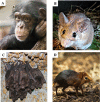Characteristics of the endometrium in menstruating species: lessons learned from the animal kingdom†
- PMID: 32129461
- PMCID: PMC7253787
- DOI: 10.1093/biolre/ioaa029
Characteristics of the endometrium in menstruating species: lessons learned from the animal kingdom†
Abstract
Here we have summarized what is currently known about menstruating animal species with special emphasis on non-primate species: length of their menstrual cycle, ovulation, implantation, placentation, decidualization, and endometrial characteristics. Having an overview of all the possible animal models that can be used to study menstruation and the menstrual cycle could be useful to select the one that better matches the needs of the individual research projects. The most promising species to study menstruation seems to be the spiny mouse Acomys cahirinus. It is a rodent that could be easily held in the existing laboratory facilities for rats and mice but with the great advantage of having spontaneous menstruation and several human-like menstrual cycle characteristics. Among the species of menstruating bats, the black mastiff bat Molossus ater and wild fulvous fruit bat Rousettus leschenaultii are the ones presenting the most human-like characteristics. The elephant shrew seems to be the less suitable species among the ones analyzed. The induced mouse model of menstruation is also presented as an adaptable alternative to study menstruation.
Keywords: endometrium; implantation; menstrual cycle; ovulation; placentation.
© The Author(s) 2020. Published by Oxford University Press on behalf of Society for the Study of Reproduction.
Figures


References
-
- Johnson MH. Essential Reproduction, Malden, MA: Blackwell; 2007.
-
- Bellofiore N, Ellery SJ, Mamrot J, Walker DW, Temple-Smith P, Dickinson H. First evidence of a menstruating rodent: the spiny mouse (Acomys cahirinus). Am J Obstet Gynecol 2017; 216:40.e41–40.e11. - PubMed
-
- Rasweiler JJ. Spontaneous decidual reactions and menstruation in the black mastiff bat, Molossus ater. Am J Anat 1991; 191:1–22. - PubMed
-
- Rasweiler JJ, de Bonilla H. Menstruation in short-tailed fruit bats (Carollia spp.). J Reprod Fertil 1992; 95:231–248. - PubMed
Publication types
MeSH terms
LinkOut - more resources
Full Text Sources
Medical

